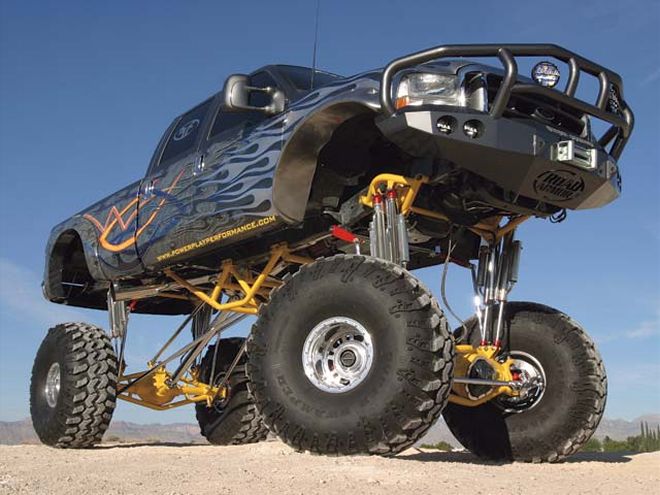
| lifted Truck Basics lifted Ford Truck
So, you want to become a part of the high life of lifted trucks and SUVs? It's like ridin' tall in the saddle in the middle of a cattle drive, but more like on a crowded freeway during rush hour. These lifted rolling beasts definitely attract attention and will intimidate many drivers around you. We must remember, every time we climb up into one of these 6,000 lb beasts, that they accelerate, turn, and stop like nothing else on the road. It's very important that these elevated rigs are built with responsibility and driven with concentration, awareness, and anticipation of what may happen while driving. Safety on and off the road is the foremost issue concerning all lifted vehicles. Lifted trucks and SUVs must share the highways and roads with smaller cars and trucks, too.
When building one of these massive maulers, there are many safety issues that must be attended to during the design and construction.
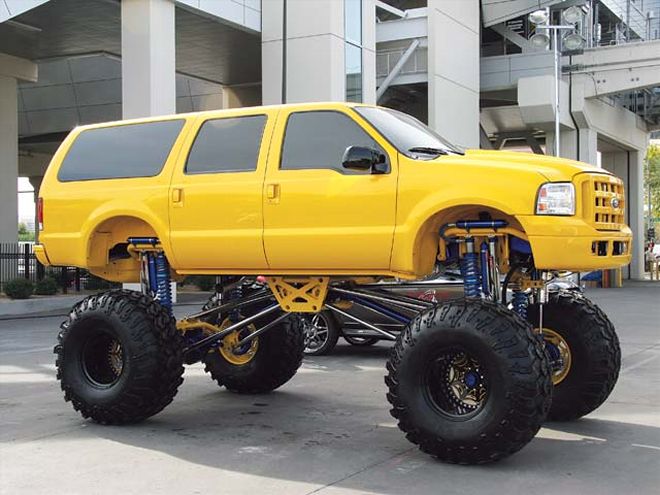
| lifted Truck Basics lifted Ford
Safety: The main safety concern pertains to the lifted vehicle's bumper height from the ground. The average car bumper height is approximately 20 inches lower than the average lifted truck or SUV. Bumpers are installed for the purpose of making contact with each other at an equal height. If a lifted truck's front or rear bumper is 20 inches taller than a car bumper, we are looking at the truck's bumper clearing the car's hood and impacting the windshield. There has been talk of making DOT crash bars mandatory on all lifted vehicles, to help eliminate stock-height vehicles from continuing underneath a lifted vehicle.
Also, it is very important that the driver of the lifted vehicle be aware of other vehicles around him or her when switching lanes, backing out, and entering small city roads. A lifted vehicle becomes naturally top heavy, which causes it to be sensitive while cornering and braking. Lifted vehicle suspension components become vital to its handling, performance, and driveability.
Major Lifted Suspension Component Concerns:
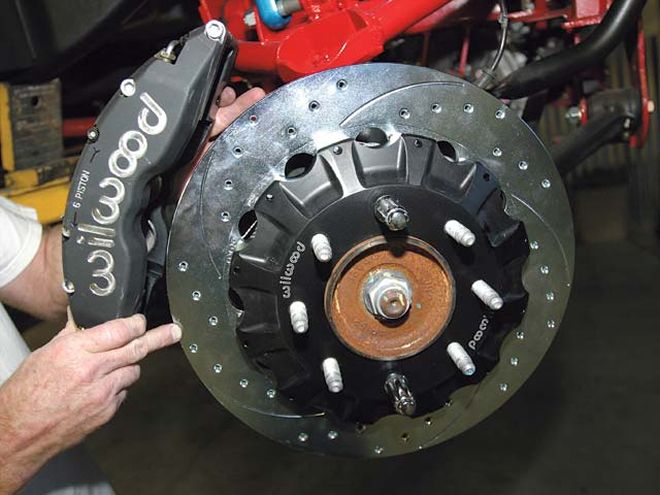
| lifted Truck Basics wilwood Brakes
Brakes:When graduating to larger diameter wheels and tires, you must also increase the caliper and rotor sizes. Due to the larger diameter wheels and tires being of a greater distance from the spindle/axle center axis, the rotating mass is multiplied, which makes a larger caliper pad and rotor surface mandatory for decelerating the wheel/tire rotation.
Layman's Terms:If you don't upgrade your brake system, it's like crossing your fingers and then slamming on the brake pedal.
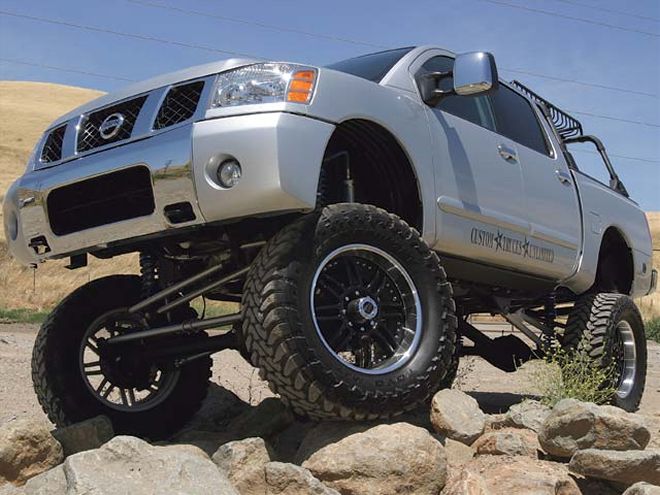
| lifted Truck Basics lifted Nissan Titan
Driveshaft Pinion Angle:The driveshaft pinion angle is a very important issue when lifting a vehicle. The pinion angle is the angle of the differential's pinion gear shaft in relation to the driveshaft. It is critical not to exceed 2-1/2 degrees of pinion angle. The universal joint is designed to handle between 1 and 3 degrees of pinion angle. These are safe operating parameters for the U-joint. If the U-joint is forced beyond these normal parameters, it can hyperextend the joint and fail.
Layman's Terms: If a spacer is not used to properly align the driveshaft, you may find yourself on the side of the road not going anywhere.
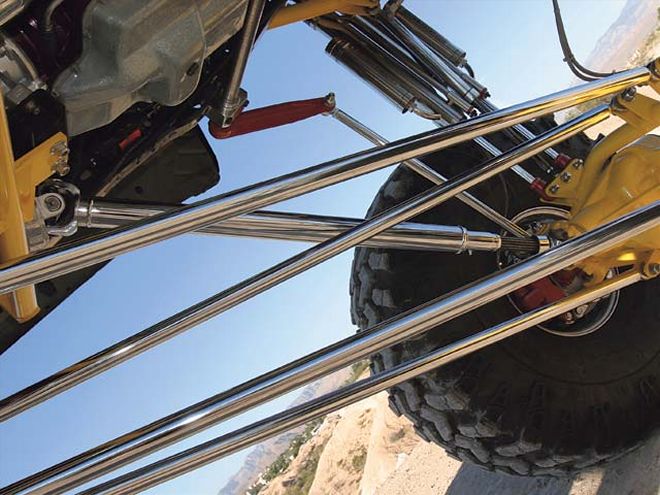
| lifted Truck Basics undercarriage Driveshaft
Driveshaft length:To assure proper driveshaft and U-joint performance, it is important the driveshaft is the correct length. When measuring the distance between the transmission output shaft and pinion gear shaft of the differential, make sure that the vehicle is at normal ride height. If the slip travel of the U-joint is 3/4 to 1 inch, this will allow the driveshaft not to bind or fallout during suspension travel.
Layman's Terms: Off-roading is fun, until you have to be towed 30 miles to a shop when your driveshaft falls out because you just had to have the huge lift.
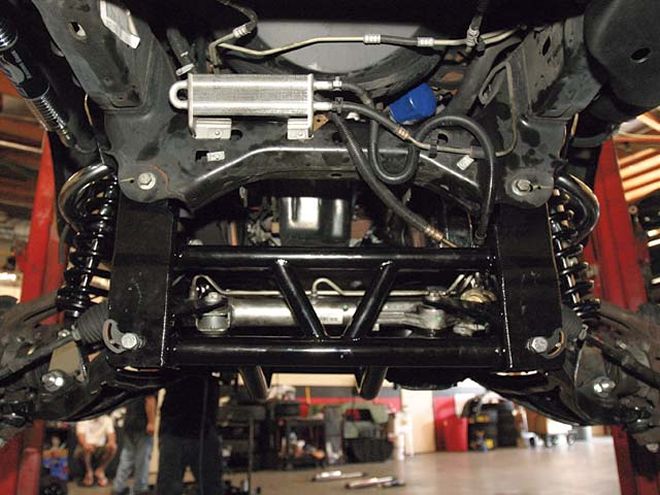
| lifted Truck Basics drop Down Bracket
Drop Down Bracket:Front suspension drop-down brackets, or a crossmember cradle, allow the vehicle's suspension pickup points to be relocated at a lower position, which allows the vehicle to be lifted without changing the suspension's travel and steering geometry.
Layman's Terms: This is a commonly used suspension lift component that does raise the truck, but doesn't add extra ground clearance for the underbelly.
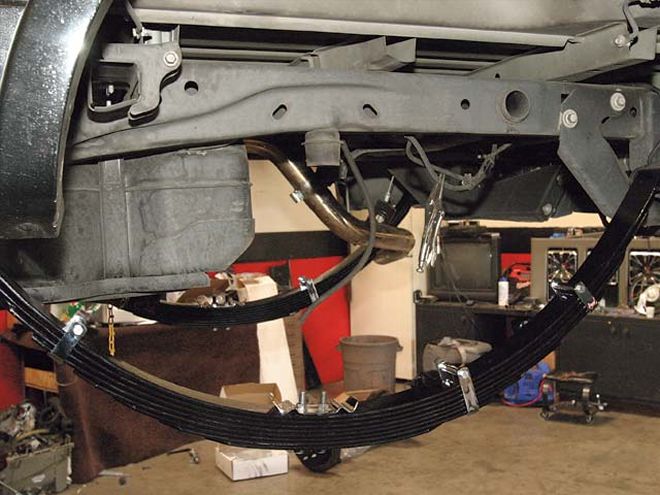
| lifted Truck Basics leaf Springs
Leaf springs:These were introduced when buckboard wagons were drawn by horses, without any shock absorbers damping the ride. Leaf springs are known as semi-elliptical springs that take on a slender profile arc, are thicker in the center, then taper at the ends. The center of the arc provides a location pin for the axle housing, and eyelet holes at each end of the spring are mounted to the frame. It is shackled at one end so it can move with the change of the arc as the suspension travel is activated. For heavy vehicles, more leaf springs are stacked on top of each other, which makes a pack to support the vehicles weight and payload. To increase ride height, the leaf-spring packs are arched accordingly.
Layman's Terms: Leaf springs are as old as the wheel and are still used today to lift trucks by adding more and thicker packs.
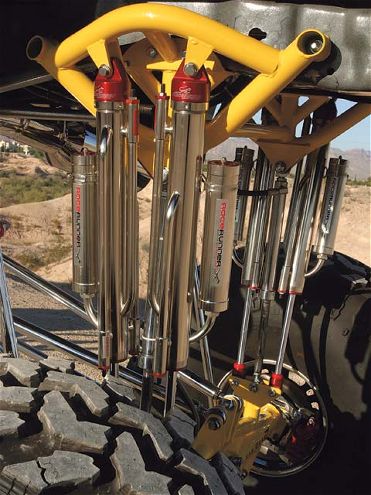
| lifted Truck Basics shocks
Shock absorbers:Mono Tube shocks with reservoir cylinder are constructed with off-road attitude and performance in mind. The shock absorber is connected at the vehicle's frame on one side, and the suspension component at the other side. The shock will damp the vehicle's spring action. A shock absorber consists of an inner cylinder (pressure), outer cylinder reservoir, piston, and piston rod. Valves are used with the piston, known as a piston valve, at the bottom of the cylinder base valve, which acts as a meter for the movement of the hydraulic fluid inside of the shock. It is the resistance of this fluid, as it moves from cylinder to cylinder, that creates the shock-damping effect.
Sway Bar/Stabilizer bar:If you are thinking of increasing the ride height of your truck, a stronger sway bar should be mandatory. The sway bar will help to eliminate body roll and maintain a flat parallel-axle plane. The round spring steel bar is connected to the frame through urethane bushings that are mounted onto the frame. The urethane bushings allow the sway bar to twist in the opposite direction of each end, under load. The ends are connected to the control arms or solid rear-axle housing by sway-bar end links. As the vehicle turns into corners, the outside tire increases in weight, while the inside tire decreases in weight. As you drive into a left-hand corner, the right tire will increase in weight as the vehicles weight is transferred from the centerline. The left tire will decrease in weight, the tighter the corner radius becomes, the greater the weight transfer becomes. The sway bar will help to maintain and control the weight transfer.
Layman's Terms:Under harsh turning conditions, the sway bar is twisted like you would ring out a towel: twisting the towel in opposite directions will help to keep your truck from flipping over.
Steering damper:As you hit a bump with one of the front tires independently, that tire will disrupt the suspension, wanting to recoil in the opposite direction, thereby causing the steering wheel to jerk back and forth. A steering damper works the same as a shock absorber, only on a parallel plane. It helps to slow down the steering frequency and bumps by steering laterally. A steering damper is recommended when installing larger wheels/tires due to the spring-weight increase to the front spindles.
Layman's Terms: For every action, there is a reaction. A steering damper will help you to control your truck.
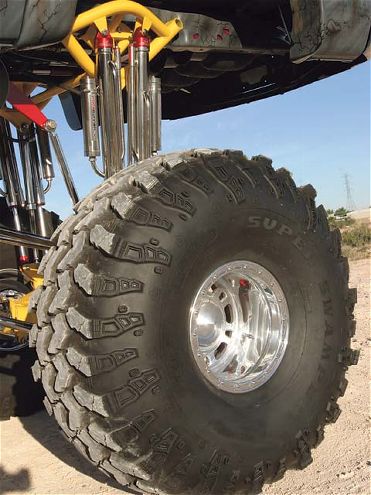
| lifted Truck Basics wheel And Shocks
Suspension Limiting Straps: Limiting straps are made of woven nylon, similar to that of safety belts and harnesses. They are installed to limit the suspension's extension travel during droop, before any damage is done due to over extension. Their lengths will vary to the suspension travel. The strap should be 1/2- to 1-inch short of the suspension's complete droop or extension travel. The straps are attached to the vehicle's frame and the shock mount bolt.
Layman's Terms: If you want to jump your rig and still drive it home, limiting straps will help to keep your suspension intact.
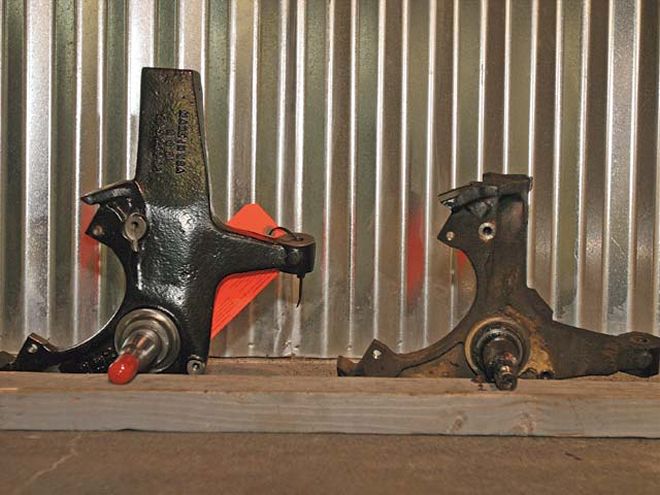
| lifted Truck Basics spindles
Spindles:Lift kits often include an elongated cast spindle/steering knuckle, with a longer shank and relocated spindle shaft. The relocation of the spindle shaft will determine the new ride height.
Layman's Terms: The knuckle is what your front wheels are mounted to. Make sure your lift spindles are from a quality manufacturer.
Dropped pitman arm:When we lift a vehicle, the OEM pitman arm must be replaced with a "dropped pitman arm." This arm will re-link the steering gear to the idler arm, acting as a lever converting torque of the steering gear to mechanical force for movement of the steering linkage. The pitman and idler arms are a weak link of the steering system when increasing wheel and tire diameter size, which increases weight. Always check these arms for extensive play and slop in the steering-wheel rotation.
Layman's Terms: If you like to steer your truck and not have it steer you, a new and more heavy-duty pitman arm is a very smart upgrade.
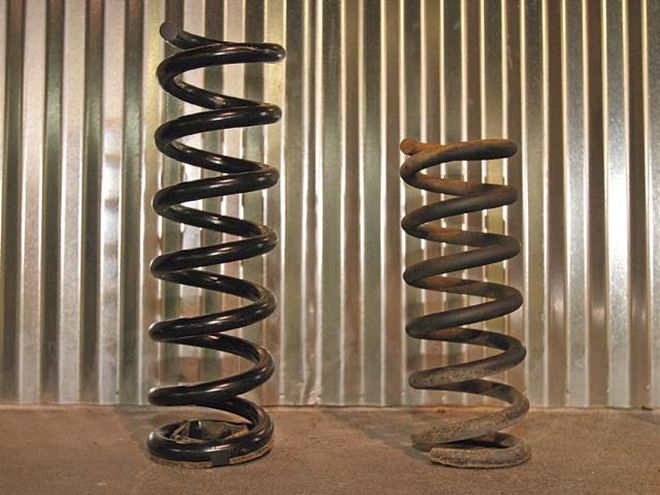
| lifted Truck Basics coil Springs
Coil spring:A coil spring is made of wound heavy-gauge steel wire that will support the vehicle's weight. The spring can be located around a shock absorber, between a lower control arm and frame, or on a rear differential and frame. A coil spring may be conical or spiral wound, at a constant rate or a progressive rate, with variable pitch spacing or use variable thickness wire. When using coil springs in an off-road application, they will tend to sag with age. It is best to replace them in pairs to maintain an even ride height from side-to-side.
The spring rate is configured by the amount of weight it takes to compress the spring one-inch. These can vary in coil length, amount of coils, how tightly they are wound, and the wire diameter.
Layman's Terms: Coil springs are often used to lift a truck, most commonly with coilover shocks. When worn, they should be replaced in pairs.
Panhard bar:The panhard bar helps to keep the rear or front differential from having any lateral movement. One end of the Panhard bar locates to the frame, while the other locates to the differential housing. It must be used when using a parallel four-bar link suspension.
Layman's Terms: The panhard bar is a vital ingredient when lifting a truck, it helps the suspension not to twist and cause excessive body roll.
Fasteners:Any time you are dealing with suspension moving parts, we can't stress enough to use high-quality Grade 8 bolts. Do not use Nylock nuts. The Nylock material can distort or weaken, melt, and then loosen and unthread. Only use castle nuts with a drilled bolt and fastened with a cotter pin, or use heavy-duty lock nuts. Make sure you always use a flat washer on both sides of the bolt head and the nut. When tightening nuts and bolts, always allow at least three threads to show above the nut. It is better to use UNF, also known as united national fine, threaded fasteners due to the fact that there are more threads per inch and more fastening grip surface, allowing it to withstand greater torque.
It is a good idea to use anti-seize when threading nuts onto bolts as it helps eliminate galling the threads.
Layman's Terms: Spend a little more at first, and save yourself a ton of money and headaches later on.
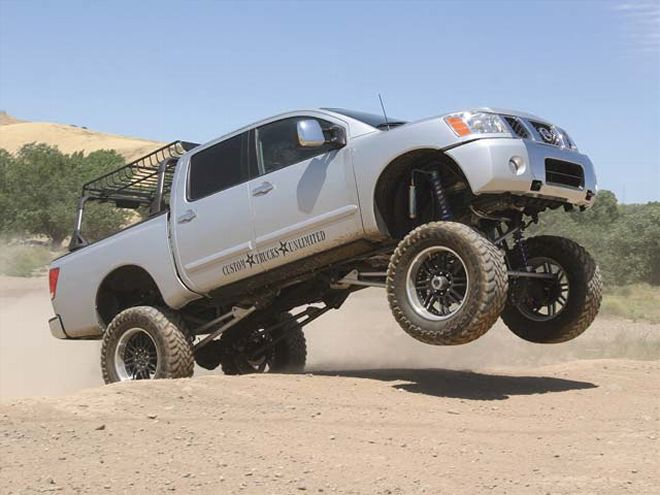
| lifted Truck Basics lifted Nissan Titan
Differential Gears:When increasing the overall tire diameter, it will affect your vehicle's gear ratio. The increase in un-sprung mass and the increased leverage of a larger diameter tire will tend to reduce your truck's overall performance and fuel mileage. The factory rear-end gear ratio was calculated to be used with a specific tire diameter, in relation to the engine's torque and power output. For example, an O.E. 4x4 Chevy truck uses an LT245/75R16 as a standard tire. This tire is approximately 30.5-inches tall. General Motors offers stock gear ratios of 3.73 or 4.10. The following information will show you how the increased tire size will effect the engine's rpm.
Layman's Terms:It takes power to turn those monster tires, and new gears will help to send more of your engine's hard work to the pavement.
30.5-inch Tall TireGear Ratio - 3.73:1; MPH - 75; RPM(Automatic) - 2,165; RPM (Manual) - 3,082
Gear Ratio - 4.10:1; MPH - 75; RPM(Automatic) - 2,372; RPM (Manual) - 3,388
33-inch Tall TireGear Ratio - 3.73:1; MPH - 75; RPM(Automatic) - 1,995; RPM (Manual) - 2,849
Gear Ratio - 4.10:1; MPH - 75; RPM(Automatic) - 2,193; RPM (Manual) - 3,131
35-inch Tall TireGear Ratio - 3.73:1; MPH - 75; RPM(Automatic) - 1,880; RPM (Manual) - 2,686
Gear Ratio - 4.10:1; MPH - 75; RPM(Automatic) - 2,192; RPM (Manual) - 2,952
37-inch Tall TireGear Ratio - 3.73:1; MPH - 75; RPM(Automatic) - 1,778; RPM (Manual) - 2,540
Gear Ratio - 4.10:1; MPH - 75; RPM(Automatic) - 1,955; RPM (Manual) - 2,792
40-inch Tall TireGear Ratio - 3.73:1; MPH - 75; RPM(Automatic) - 1,645; RPM (Manual) - 2,350
Gear Ratio - 4.10:1; MPH - 75; RPM(Automatic) - 1,880; RPM (Manual) - 2,583
Lifted Vehicle State Laws:You can check your local state elevated ride-height laws by going to the authorities website: www.stateabbreviation.gov.
The website will give you all of the on-road and off-road information involving suspension limitations of a vehicle per weight GVWR and the ride height.
 | lifted Truck Basics lifted Ford Truck
So, you want to become a part of the high life of lifted trucks and SUVs? It's like ridin' tall in the saddle in the middle of a cattle drive, but more like on a crowded freeway during rush hour. These lifted rolling beasts definitely attract attention and will intimidate many drivers around you. We must remember, every time we climb up into one of these 6,000 lb beasts, that they accelerate, turn, and stop like nothing else on the road. It's very important that these elevated rigs are built with responsibility and driven with concentration, awareness, and anticipation of what may happen while driving. Safety on and off the road is the foremost issue concerning all lifted vehicles. Lifted trucks and SUVs must share the highways and roads with smaller cars and trucks, too.
| lifted Truck Basics lifted Ford Truck
So, you want to become a part of the high life of lifted trucks and SUVs? It's like ridin' tall in the saddle in the middle of a cattle drive, but more like on a crowded freeway during rush hour. These lifted rolling beasts definitely attract attention and will intimidate many drivers around you. We must remember, every time we climb up into one of these 6,000 lb beasts, that they accelerate, turn, and stop like nothing else on the road. It's very important that these elevated rigs are built with responsibility and driven with concentration, awareness, and anticipation of what may happen while driving. Safety on and off the road is the foremost issue concerning all lifted vehicles. Lifted trucks and SUVs must share the highways and roads with smaller cars and trucks, too. | lifted Truck Basics lifted Ford
Safety:
| lifted Truck Basics lifted Ford
Safety:  | lifted Truck Basics wilwood Brakes
Brakes:
| lifted Truck Basics wilwood Brakes
Brakes: | lifted Truck Basics lifted Nissan Titan
Driveshaft Pinion Angle:
| lifted Truck Basics lifted Nissan Titan
Driveshaft Pinion Angle: | lifted Truck Basics undercarriage Driveshaft
Driveshaft length:
| lifted Truck Basics undercarriage Driveshaft
Driveshaft length: | lifted Truck Basics drop Down Bracket
Drop Down Bracket:
| lifted Truck Basics drop Down Bracket
Drop Down Bracket: | lifted Truck Basics leaf Springs
Leaf springs:
| lifted Truck Basics leaf Springs
Leaf springs: | lifted Truck Basics shocks
Shock absorbers:
| lifted Truck Basics shocks
Shock absorbers: | lifted Truck Basics wheel And Shocks
Suspension Limiting Straps:
| lifted Truck Basics wheel And Shocks
Suspension Limiting Straps:  | lifted Truck Basics spindles
Spindles:
| lifted Truck Basics spindles
Spindles: | lifted Truck Basics coil Springs
Coil spring:
| lifted Truck Basics coil Springs
Coil spring: | lifted Truck Basics lifted Nissan Titan
Differential Gears:
| lifted Truck Basics lifted Nissan Titan
Differential Gears: